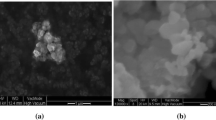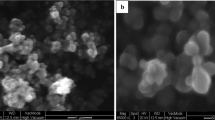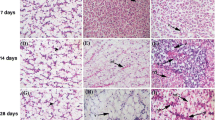Abstract
Zinc oxide nanoparticles (ZnO-NPs) are being widely used in numerous industrial and commercial applications. This study was designed to investigate the possible mechanisms of bioaccumulation, oxidative stress, histopathological alterations and genotoxicity induced by ZnO-NPs to tilapia (Oreochromis mossambicus). The study showed maximum Zn accumulation of 3.0643 mg/kg (p < 0.05) in liver at highest concentration of 1.5 mg/L in T3. ZnO-NPs induced oxidative stress as indicated by the significantly increased LPO level in gills as compared to liver (p < 0.05). The increased lipid peroxidase (LPO) and superoxide dismutase (SOD) levels were observed in gills than liver. Similar results were observed for catalase (CAT) and glutathione (GSH) in gills. In case of histological alterations, gill oedema and hyperplasia, fusion of gill lamellae and thickening of primary and secondary gill lamellae were observed. In liver, necrosis and apoptosis with condensed nuclear bodies and pyknotic nuclei were observed. The genotoxic potential was investigated by evaluating DNA strands break using alkaline comet assay, and significant DNA damage was observed in the erythrocytes when exposed for ZnO-NPs. The % tail DNA was increased with the increasing concentration of ZnO-NPs, and similar pattern was shown in olive tail movement. Overall, we conclude that the ZnO-NPs have the potential to accumulate in the soft tissues, causing respiratory distress such as oxidative stress, induction of antioxidant defence mechanism by raising glutathione (GSH), organ pathology and genotoxicity. These results suggest the potential ecotoxicological effects of nanoparticles in understanding their uptake and effects on aquatic biota.




Similar content being viewed by others
References
Adel Abdel-Khalek A, Kadry M, Hamed A, Marie MA (2015) Ecotoxicological impacts of zinc metal in comparison to its nanoparticles in Nile tilapia; Oreochromis niloticus. J Basic Appl Zool 72:113–125
Ali D, Alarifi S, Kumar S, Ahamed M, Siddiqui MA (2012) Oxidative stress and genotoxic effect of zinc oxide nanoparticles in freshwater snail Lymnaea luteola L. Aquat Toxicol 124:83–90
APHA (2005) Standard methods for the examination of water and wastewater, 21st edn. American Public Health Association, Washington DC
Asagba SO, Eriyamremu GE, Igberaese ME (2008) Bioaccumulation of cadmium and its biochemical effect on selected tissues of the catfish (Clarias gariepinus). Fish Physiol Biochem 34(1):61–69
Aschberger K, Micheletti C, Sokull-Klüttgen B, Christensen FM (2011) Analysis of currently available data for characterising the risk of engineered nanomaterials to the environment and human health—lessons learned from four case studies. Environ Int 37(6):1143–1156
Ates M, Arslan Z, Demir V, Daniels J, Farah IO (2015) Accumulation and toxicity of CuO and ZnO nanoparticles through waterborne and dietary exposure of goldfish (Carassius auratus). Environ Toxicol 30(1):119–128
Ballesteros ML, Wunderlin DA, Bistoni MA (2009) Oxidative stress responses in different organs of Jenynsia multidentata exposed to endosulfan. Ecotoxicol Environ Saf 72(1):199–205
Bernet D, Schmidt H, Meier W, Burkhardt-Holm P, Wahli T (1999) Histopathology in fish: proposal for a protocol to assess aquatic pollution. J Fish Dis 22(1):25–34
Blaise C, Gagné F, Férard JF, Eullaffroy P (2008) Ecotoxicity of selected nano-materials to aquatic organisms. Environ Toxicol 23(5):591–598
Bressler K, Ron B (2004) Effect of anesthetics on stress and the innate immune system of gilthead bream (Sparus aurata). Israeli J Aquacult 56:5–13
Bucher F, Hofer R (1993) The effects of treated domestic sewage on three organs (gills, kidney, liver) of brown trout (Salmo trutta). Water Res 27(2):255–261
Buege JA, Aust SD (1978) Microsomal lipid peroxidation. Methods Enzymol 52:302–310
Cao L, Huang W, Shan X, Ye Z, Dou S (2012) Tissue-specific accumulation of cadmium and its effects on antioxidative responses in Japanese flounder juveniles. Environ Toxicol Pharmacol 33(1):16–25
Chaubey RC (2005) Computerized image analysis software for the comet assay. In Molecular toxicology protocols. Humana Press, pp 97–106
Claiborne A (1985) Catalase activity. In: Greenland RA (ed) CRC handbook of methods in oxygen radical research. CRC Press, Boca Raton, pp 283–284
Dorval J, Leblond VS, Hontela A (2003) Oxidative stress and loss of cortisol secretion in adrenocortical cells of rainbow trout (Oncorhynchus mykiss) exposed in vitro to endosulfan, an organochlorine pesticide. Aquat Toxicol 63(3):229–241
Dowling A, Clift R, Grobert N, Hutton D, Oliver R, O’neill O, Seaton A (2004) Nanoscience and nanotechnologies: opportunities and uncertainties. R Soc R Acad Eng Rep 61:e64
Fan W, Li Q, Yang X, Zhang L (2013) Zn subcellular distribution in liver of goldfish (Carassius auratus) with exposure to zinc oxide nanoparticles and mechanism of hepatic detoxification. PLoS ONE 8(11):e78123
Farré M, Gajda-Schrantz K, Kantiani L, Barceló D (2009) Ecotoxicity and analysis of nanomaterials in the aquatic environment. Anal Bioanal Chem 393(1):81–95
Hackenberg S, Scherzed A, Technau A, Kessler M, Froelich K, Ginzkey C, Kleinsasser N (2011) Cytotoxic, genotoxic and pro-inflammatory effects of zinc oxide nanoparticles in human nasal mucosa cells in vitro. Toxicol In Vitro 25(3):657–663
Hao L, Chen L (2012) Oxidative stress responses in different organs of carp (Cyprinus carpio) with exposure to ZnO nanoparticles. Ecotoxicol Environ Saf 80:103–110
Hao L, Chen L, Hao J, Zhong N (2013) Bioaccumulation and sub-acute toxicity of zinc oxide nanoparticles in juvenile carp (Cyprinus carpio): a comparative study with its bulk counterparts. Ecotoxicol Environ Saf 91:52–60
Humason GL (1979) Animal tissue technique, 4th edn. W.H.Freeman and Company, San Francisco, p 61
Jollow DJ, Mitchell JR, Zampaglione NA, Gillette JR (1974) Bromobenzene-induced liver necrosis. Protective role of glutathione and evidence for 3, 4-bromobenzene oxide as the hepatotoxic metabolite. Pharmacology 11(3):151–169
Kaya H, Akbulut M (2015) Effects of waterborne lead exposure in mozambique tilapia: oxidative stress, osmoregulatory responses, and tissue accumulation. J Aquat Anim Health 27(2):77–87
Kaya H, Akbulut M, Çelik EŞ, Yılmaz S (2013) Impacts of sublethal lead exposure on the hemato-immunological parameters in tilapia (Oreochromis mossambicus). Toxicol Environ Chem 95(9):1554–1564
Kaya H, Aydın F, Gürkan M, Yılmaz S, Ates M, Demir V, Arslan Z (2015) Effects of zinc oxide nanoparticles on bioaccumulation and oxidative stress in different organs of tilapia (Oreochromis niloticus). Environ Toxicol Pharmacol 40(3):936–947
Kaya H, Aydın F, Gürkan M, Yılmaz S, Ates M, Demir V, Arslan Z (2016a) A comparative toxicity study between small and large size zinc oxide nanoparticles in tilapia (Oreochromis niloticus): organ pathologies, osmoregulatory responses and immunological parameters. Chemosphere 144:571–582
Kaya H, Duysak M, Akbulut M, Yılmaz S, Gürkan M, Arslan Z, Ateş M (2016b) Effects of subchronic exposure to zinc nanoparticles on tissue accumulation, serum biochemistry, and histopathological changes in tilapia (Oreochromis niloticus). Environ Toxicol. https://doi.org/10.1002/tox
Kong X, Wang G, Li S (2007) Antioxidation and ATPase activity in the gill of mud crab Scylla serrata under cold stress. Chin J Oceanol Limnol 25:221–226
Korai AL, Lashari KH, Sahato GA, Kazi TG (2010) Histological lesions in gills of feral cyprinids, related to the uptake of waterborne toxicants from Keenjhar lake. Rev Fish Sci 18(2):157–176
Li H, Zhou Q, Wu Y, Fu J, Wang T, Jiang G (2009) Effects of waterborne nano-iron on medaka (Oryzias latipes): antioxidant enzymatic activity, lipid peroxidation and histopathology. Ecotoxicol Environ Saf 72(3):684–692
Liu Y, Wang J, Wei Y, Zhang H, Xu M, Dai J (2008) Induction of time-dependent oxidative stress and related transcriptional effects of perfluorododecanoic acid in zebrafish liver. Aquat Toxicol 89(4):242–250
Mallat J (1985) Fish gill structural changes induced by toxicants and others irritants: a statistical review. Can J Fish Aquat Sci 42:630–648
Marklund S, Marklund G (1974) Involvement of the superoxide anion radical in the autoxidation of pyrogallol and a convenient assay for superoxide dismutase. Eur J Biochem 47(3):469–474
Nel A, Xia T, Mädler L, Li N (2006) Toxic potential of materials at the nanolevel. Science 311(5761):622–627
Osmond MJ, Mccall MJ (2010) Zinc oxide nanoparticles in modern sunscreens: an analysis of potential exposure and hazard. Nanotoxicology 4(1):15–41
Pandey S, Parvez S, Sayeed I, Haque R, Bin-Hafeez B, Raisuddin S (2003) Biomarkers of oxidative stress: a comparative study of river Yamuna fish Wallago attu (Bl. & Schn.). Sci Total Environ 309(1):105–115
Piccinno F, Gottschalk F, Seeger S, Nowack B (2012) Industrial production quantities and uses of ten engineered nanomaterials in Europe and the world. J Nanopart Res 14(9):1–11
Ruas CBG, dos Santos Carvalho C, de Araújo HSS, Espíndola ELG, Fernandes MN (2008) Oxidative stress biomarkers of exposure in the blood of cichlid species from a metal-contaminated river. Ecotoxicol Environ Saf 71(1):86–93
Saber TH (2011) Histological adaptation to thermal changes in gills of common carp fishes Cyprinus carpio L. Rafidain J Sci 22:46–55
Saddick S, Afifi M, Zinada OAA (2015) Effect of Zinc nanoparticles on oxidative stress-related genes and antioxidant enzymes activity in the brain of Oreochromis niloticus and Tilapia zillii. Saudi J Biol Sci 24(7):1672–1678
Sayeed I, Parvez S, Pandey S, Bin-Hafeez B, Haque R, Raisuddin S (2003) Oxidative stress biomarkers of exposure to deltamethrin in freshwater fish, Channa punctatus Bloch. Ecotoxicol Environ Saf 56(2):295–301
Shahzad K, Khan MN, Jabeen F, Kosour N, Sohail M, Khan MKA, Ahmad M (2017) Bioaccumulation of manufactured titanium dioxide (TiO2), copper oxide (CuO) and zinc oxide (ZnO) nanoparticles in soft tissues of tilapia (Oreochromis mossambicus). Punjab Univ J Zool 32(2):237–243
Singh NP, McCoy MT, Tice RR, Schneider EL (1988) A simple technique for quantitation of low levels of DNA damage in individual cells. Exp Cell Res 175(1):184–191
Sohail M, Khan MN, Chaudhry AS, Qureshi NA (2016a) Bioaccumulation of heavy metals and analysis of mineral element alongside proximate composition in foot, gills and mantle of freshwater mussels (Anodonta anatina). Rendiconti Lincei 27(4):687–696
Sohail M, Khan MN, Chaudhry AS, Shahzad K (2016b) Proximate composition and elemental analysis in soft tissues of freshwater mussels (Anodonta anatina) from the Chashma Lake, River Indus Pakistan. Front Biol 11(4):331–337
Sohail M, Khan MN, Qureshi NA, Chaudhry AS (2017) Monitoring DNA damaging in gills of freshwater mussels (Anodonta anatina) exposed to heavy metals. Pak J Zool 49(1):305–311
Subashkumar S, Selvanayagam M (2014a) First report on: acute toxicity and gill histopathology of fresh water fish Cyprinus carpio exposed to Zinc oxide (ZnO) nanoparticles. Int J Sci Res Publ 3:1–4
Subashkumar S, Selvanayagam M (2014b) Zinc oxide (ZnO) nanoparticles induced histopathological changes in the liver of freshwater fish (Cyprinus carpio). Cibtech J Zool 3(3):74–77
Suganthi P, Murali M, Sadiq Bukhari A, Syed Mohamed HE, Basu H, Singhal RK (2015) Behavioural and Histological variations in Oreochromis mossambicus after exposure to ZnO Nanoparticles. Int J Adv Res 1(8):524–531
Tabrez S, Ahmad M (2011) Oxidative stress mediated genotoxicity of wastewaters collected from two different stations in northern India. Mutat Res 726(1):15–20
WenJing T, Wei B, ChunLu Z, ZhiYong Z, JunAn C, Xiao H, YuLiang Z (2010) Effects of ZnO nanoparticles on antioxidant enzyme system of zebrafish embryos. China Environ Sci 30(5):705–709
Xiong D, Fang T, Yu L, Sima X, Zhu W (2011) Effects of nano-scale TiO2, ZnO and their bulk counterparts on zebrafish: acute toxicity, oxidative stress and oxidative damage. Sci Total Environ 409(8):1444–1452
Zhao X, Wang S, Wu Y, You H, Lv L (2013) Acute ZnO nanoparticles exposure induces developmental toxicity, oxidative stress and DNA damage in embryo-larval zebrafish. Aquat Toxicol 136:49–59
Acknowledgments
The authors wish to thank all who assisted in conducting this work.
Author information
Authors and Affiliations
Corresponding author
Additional information
Editorial responsibility: Zhenyao Shen.
Rights and permissions
About this article
Cite this article
Shahzad, K., Khan, M.N., Jabeen, F. et al. Toxicity of zinc oxide nanoparticles (ZnO-NPs) in tilapia (Oreochromis mossambicus): tissue accumulation, oxidative stress, histopathology and genotoxicity. Int. J. Environ. Sci. Technol. 16, 1973–1984 (2019). https://doi.org/10.1007/s13762-018-1807-7
Received:
Revised:
Accepted:
Published:
Issue Date:
DOI: https://doi.org/10.1007/s13762-018-1807-7




